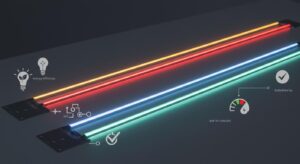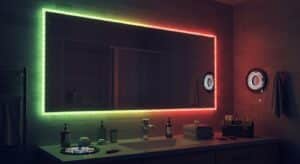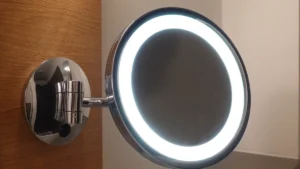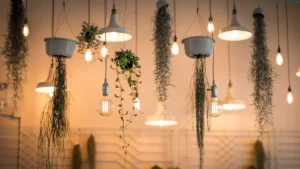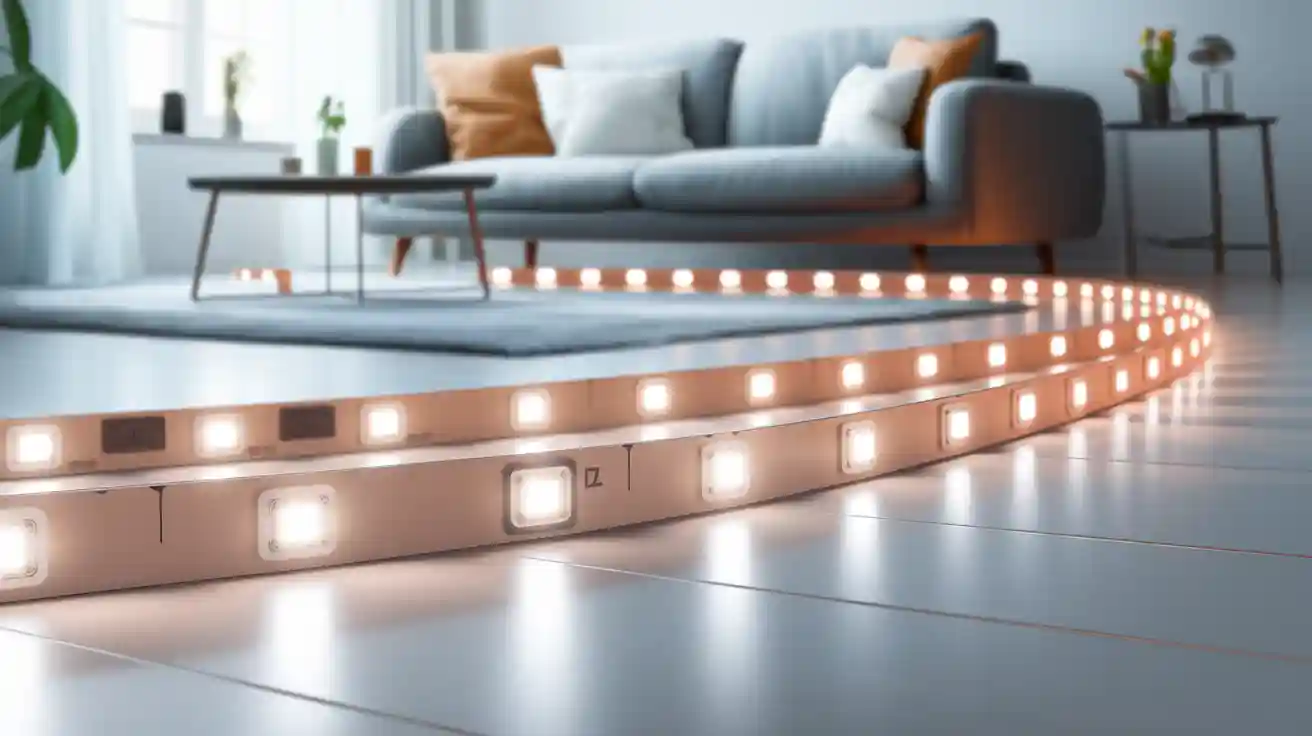
Choosing the best bright LED strip lights helps them last longer. These lights are flexible and make homes look nicer. They also improve the look of businesses. They save energy and lower electricity bills while staying bright.
Many things affect how long they last. Good LED strip lights are made with strong materials like double-layer copper PCBs. These materials handle heat well and stop overheating. Installing them properly keeps them safe from shaking. Cleaning them often helps them stay bright. For outdoor use, check their IP ratings to ensure they can handle weather.
So, how do you pick LED strip lights that last? Let’s find out.
Key Takeaways
Pick LED strip lights made with strong materials like double-layer copper PCBs. These last longer and handle heat better.
Choose the right brightness for your needs. Use a lumens chart to find the best level for accent, task, or industrial lighting.
Check the IP rating to make sure outdoor LED strips can handle weather. IP65 or higher works well outside.
Go for LED strips with a high Colour Rendering Index (CRI) of 80 or more. This gives better colour and looks nicer.
Think about dimmable or smart-controlled LED strips. They save energy and make lighting more flexible and fun to use.
Understanding LED Strip Lights
What Are LED Strip Lights
LED strip lights are bendable lights with small LEDs on a flat strip. They come in different sizes to match your design needs. Many have sticky backs, so they are easy to put up.
How well these lights work depends on a few things. Strong materials like thick boards and good soldering make them last longer. Managing heat properly stops them from getting too hot, which keeps them working longer. Keeping the colours even is also important for a nice look.
Some LED strips have special ratings called IP ratings. These show how well they resist dust and water. For example, IP65 means they can handle dust and water sprays, so they’re good for outside. Always look for safety labels like CE and RoHS to make sure they are safe and work well.
Common Applications for LED Strip Lights
LED strips can be used in many ways. Here are some examples:
Auxiliary Lighting: Brighten dark spots like under shelves or inside closets.
Decorative Lighting: Make homes or shops look more stylish with soft lights.
Task Lighting: Give bright light for jobs like reading or cooking.
Plant Growth Lighting: Help plants grow with special LEDs for their needs.
At home, people like LED strips because they save energy and feel cosy. Businesses use them because they are cheap to maintain and work well. Factories like them for saving money and giving steady light. Outside, they light up streets, buildings, and gardens while looking nice.
Application Type | Description |
|---|---|
Residential | Cosy, energy-saving lights that look good |
Commercial | Low-cost, easy-to-maintain lights for shops |
Industrial | Money-saving, steady lights for workspaces |
Outdoor | Eco-friendly lights for streets and buildings |
Sports Complexes | Bright, even lights for stadiums |
Tunnels | Safe, energy-saving lights for better visibility |
LED strip lights are useful for many things, making them a smart choice for homes and businesses.
Key Factors to Consider
When picking bright LED strip lights for long-term use, think about a few important things. These will help you get lights that last and work well.
Brightness and Lumens Per Foot
The brightness of LED strip lights is measured in lumens per foot. This tells you how much light the strip gives over a certain length. The right brightness depends on what you need the light for. For example, accent lighting needs fewer lumens than task lighting.
Here’s a table to guide you on lumens for different uses:
Application Type | Lumens per Foot Range |
|---|---|
Accent Lighting and Mood Lighting | 100 to 350 lumens/ft |
Under Cabinet Lighting | 175 to 525 lumens/ft |
Task Lighting (low distance) | 280 to 437 lumens/ft |
Task Lighting (high distance) | 500 to 1000 lumens/ft |
Indirect Lighting (various settings) | 375 to 562 lumens/ft |
Industrial Lighting | 500 to 950 lumens/ft |
For brighter spaces like factories or work areas, choose LED strips with higher lumens. This makes sure the space is well-lit.
Colour Temperature and CRI
Colour temperature and CRI (Colour Rendering Index) are important for how the light looks and works. Colour temperature, measured in Kelvin (K), shows if the light is warm or cool. Lower numbers, like 2700K, give a soft, warm glow. Higher numbers, like 6500K, look like bright daylight.
CRI shows how well the light shows colours. A high CRI, like 90 or more, makes colours look clear and real. For most uses, pick LED strips with a high CRI for better colour quality.
A basic white LED has a CRI of about 70, which isn’t great for tasks needing clear colours.
The Kruithof curve explains how people see colour temperature at different brightness levels. For dim lights, 2700K feels ‘white’ and works well for cosy lighting.
A tungsten bulb with CRI=100 might not show colours like yellow or navy well. But a 6500K CFL with CRI=82 shows these colours better.
Choosing the right colour temperature and CRI makes your LED strip lights both useful and comfortable.
Durability and IP Ratings
Durability matters when picking LED strip lights, especially for outdoor or tough jobs. IP ratings (Ingress Protection Ratings) show how well the lights resist dust and water. For example, IP65 means the strip is safe from dust and water sprays, so it’s good for outside.
Manufacturers test LED strips for water resistance and give certifications to prove they’re reliable. Look for these IP ratings:
IP65: Keeps out dust and resists water sprays.
IP66: Keeps out dust and resists strong water jets.
IP68: Keeps out dust and can go underwater.
These ratings follow global standards (IEC 60529) and show how tough the strip is. Always pick LED strips with the right IP rating for your needs to make sure they last.
Tip: For outdoor use, choose waterproof LED strips with at least an IP65 rating to handle weather.
By thinking about these points, you can find LED strip lights that are bright, colourful, and long-lasting for your needs.
Power Supply and Energy Efficiency
The power supply is very important for LED strip lights. It affects how well they work and how long they last. Always pick a power source that matches the voltage and wattage of your LED strips. If they don’t match, the lights might overheat or not work properly. This can make your lighting less effective.
LED strip lights are great because they save energy. They use much less power than old-fashioned lights but still shine brightly. For example, dimming systems in LED strips can cut energy use by 75.65%. Tests show dimmed lights used only 152.1 watts from 9:00 to 18:00. Normal lights used 624.62 watts in the same time. This makes LED strips a smart choice to lower electricity costs.
To save even more energy, choose LED strips with dimming or smart controls. These let you change the brightness to fit your needs. Also, make sure the power supply has safety features like surge protection. This stops damage if the voltage changes suddenly.
Tip: Check the specs of your LED strips and power supply. This avoids problems and helps your lights last longer.
Material and Build Quality
Good materials and build quality make LED strips last longer and work better. Strong materials help spread heat, use power well, and keep the light steady. When buying LED strips, look at these things:
LED Types: SMD and COB LEDs give different brightness and lifespans. COB LEDs shine smoothly without bright spots.
Copper Wire in PCB: Good copper wire moves power well and wastes less energy.
Phosphor Quality: High-quality phosphor makes colours look better and lights more appealing.
Component Placement: Properly placed parts on the PCB help the lights work well and avoid problems.
Manufacturers test LED strips to make sure they are reliable. Burn-in tests run LEDs for 8–12 hours to check performance. Photometric tests (LM-79) measure brightness and colour. LM-80 tests check how long LED chips last and if their colours stay stable. These tests prove the strips meet industry standards.
Buying from trusted brands is also important. Well-known companies follow strict rules to make good products. By choosing high-quality LED strips, you get lights that stay bright and work well for a long time.
Note: Pick LED strips with a Colour Rendering Index (CRI) of 80 or more. Higher CRI makes colours look more real and vibrant.
Types of LED Strip Lights
RGB and RGBW LED Strip Lights
RGB and RGBW LED strips are great for colourful lighting. RGB strips mix red, green, and blue to make many colours. They work well for decoration, like brightening living rooms or shop displays. RGBW strips are even better because they add a white LED. This gives brighter and cleaner white light than RGB strips can make.
RGBW strips are useful where you need both colour and clear white light. Fancy shops and museums use them to switch between colourful lights and bright white. This makes products and art look more attractive. RGB strips cost less, but RGBW strips give better brightness and light quality. They are worth it for spaces needing both styles of lighting.
Tip: Pick RGBW strips for better white light and accurate colours.
COB LED Strip Lights
COB (Chip-on-Board) LED strips are a big step forward. They put many LEDs close together on one board. This makes the light very bright and smooth. COB strips are great for lighting large areas evenly. You can use them at home, in shops, or in factories.
COB strips save energy while staying bright. Their design helps them stay cool, so they last longer. They work well for lighting workspaces or making homes feel cosy. COB strips shine without showing bright spots, giving a steady glow.
Why Choose COB LED Strips:
Smooth light for many uses.
Bright enough for big spaces.
Stay cool for longer life.
Use less energy than older LEDs.
Waterproof LED Strip Lights
Waterproof LED strips are made for tough places. They have IP ratings like IP65, IP67, and IP68. IP65 strips handle splashes, IP67 strips can go underwater briefly, and IP68 strips work fully underwater. These are perfect for pools, fountains, or outdoor areas.
Manufacturers test waterproof strips carefully to make sure they last. Tests check heat, ageing, and water resistance. Certifications like CE and RoHS prove they are safe and high-quality. You can use them outside in gardens, patios, or buildings, knowing they’ll work well in bad weather.
Specification | Details |
|---|---|
Waterproof Rating | IP65 / IP67 / IP68 |
Certifications | CE, RoHS, UL, ETL, SAA |
Note: For outdoor use, pick strips with at least an IP65 rating. They will last longer and handle weather better.
Dimmable and Smart-Controlled LED Strips
Dimmable and smart-controlled LED strips let you customise your lighting easily. You can change brightness and set up unique lighting styles. These features make them great for homes and businesses. Whether you want a cosy vibe or bright light for work, these strips are very flexible.
Benefits of Dimmable LED Strips
Dimmable LED strips let you control how bright the lights are. This helps you create the right mood for any activity. Lower brightness reduces glare, making it easier on your eyes. It also saves energy because dimmed lights use less power. For example, dim the lights during a movie night for a cinema feel. In offices, dimming lights can reduce eye strain and boost comfort.
Smart-Controlled LED Strips: The Future of Lighting
Smart-controlled LED strips make lighting even more convenient. They connect to apps or smart home systems for remote control. You can change brightness, pick colours, or schedule lighting times. Imagine waking up to soft light or having lights dim automatically at bedtime. Smart controls also allow automation, making your lighting system efficient and personalised.
Advantages of Dimmable and Smart-Controlled LED Strips
The table below shows the main benefits of these LED strips:
Advantage | Description |
|---|---|
Mood Control | Adjust brightness to create the right atmosphere for activities. |
Glare Reduction | Lower brightness to reduce eye strain and discomfort. |
Smart Control Integration | Use apps or voice assistants to manage lighting remotely. |
Energy Efficiency | Save energy and money with dimming features in homes or offices. |
Tip: Use smart-controlled LED strips with Alexa or Google Assistant for easy voice commands.
Why Choose Dimmable and Smart-Controlled LED Strips?
These LED strips mix style with smart features. They make your space look better and work smarter. By choosing these options, you get lights that adapt to your needs and save energy. Whether for home upgrades or business use, they are a practical and modern choice.
Installation and Practical Considerations
Preparing the Surface for Installation
Getting the surface ready is key for installing LED strips. A clean, smooth surface helps the adhesive stick well and stops peeling later. Follow these simple steps:
Wipe the surface to remove dirt, grease, or dust. Use alcohol or a damp cloth.
Make sure the surface is dry before sticking the LED strip.
Wait for paint to fully dry if the surface is painted.
Sand rough areas lightly with fine sandpaper for better sticking.
Tip: Install the LED strips when the surface is warmer than 15ºC (60ºF). This helps the adhesive work better.
Doing this makes the surface ready and keeps your LED strips secure for a long time.
Choosing the Right Adhesive or Mounting Method
Picking the right adhesive or mounting method keeps your LED strips in place. Strong tapes like 3M VHB are popular because they stick well and last long. Here’s a comparison of some good options:
Tape Model | Thickness (mm) | Width (mm) | Bonding Strength (N/cm) | Temperature Resistance (°C) | Colour | Tensile Strength (MPa) | Elongation (%) |
|---|---|---|---|---|---|---|---|
3M VHB 5952 | 1.1 | 50 | 180 | -40 to 150 | Black | 3.4 | 500 |
3M VHB 4941 | 0.8 | 25 | 100 | -40 to 100 | Transparent | 2.7 | 400 |
3M VHB 5925 | 0.63 | 12 | 80 | -40 to 93 | Black | 2.1 | 300 |
For heavier strips or uneven surfaces, use clips or brackets for extra support. These are helpful in places with high humidity or changing temperatures.
Note: Pick an adhesive or mounting method that suits the weight and location of your LED strips.
Wiring and Power Connections
Good wiring and power connections keep your LED strips safe and working well. Bad connections can cause uneven light or damage. Follow these tips:
Match the power supply voltage to the LED strip’s needs.
Connect the power supply correctly to avoid harming the LEDs.
Use a steady power source to stop voltage surges or unstable current.
Choose the right wire size to reduce resistance for long strips.
Secure connections with heat shrink tubing or proper connectors to avoid problems.
Tip: Don’t bend the LED strip too tightly. Keep bends wider than 60mm to protect the LED beads.
By following these steps, your LED strips will work safely and give bright light for a long time.
Switching and Control Mechanisms
Switching and control systems help you manage your LED strip lights. They let you turn lights on or off, change brightness, and even switch colours. Picking the right control system makes using your lights easier and more effective.
Types of Switching Mechanisms
Manual Switches: These are the easiest to use. A wall switch or a small inline switch can control the lights. This is good for simple setups without extra features.
Remote Controls: Some LED strips come with remotes. These let you change brightness, pick colours, or use pre-set modes from far away.
Smart Switches: These work with smart home devices. You can control lights using apps or voice commands with Alexa or Google Assistant.
Advanced Control Options
For more options, try advanced control systems. Dimmers let you set the brightness to match your mood or task. Wi-Fi or Bluetooth controllers allow you to adjust settings on your phone. Some systems even let you schedule when lights turn on or off automatically.
Tip: Make sure the control system matches your LED strip’s voltage and wattage. This avoids problems and keeps everything working smoothly.
By choosing the right controls, you can make your LED lights more useful and modern for your space.
Quality Assurance and Certifications
Why Certifications Matter
Certifications prove that LED strip lights are safe and meet standards. Labels like CE in Europe and UL in the US show they follow health and safety rules. Without these, the lights might break quickly or be unsafe to use.
When buying LED strips, check for trusted certifications. These include:
UL Listing: Confirms the product is safe for electrical use.
RoHS Compliance: Ensures no harmful materials like lead or mercury are used.
REACH Certification: Shows the product is environmentally friendly.
Certified products go through strict tests for durability, heat control, and colour accuracy. Choosing certified lights helps you avoid poor-quality options.
Tip: Look for certification labels on the box or ask the seller for proof.
Spotting High-Quality LED Strips
To find good LED strips, check their parts and performance. Reliable brands share test results and use strong materials for lasting quality.
Here’s a quick guide:
What to Check | Why It’s Important |
|---|---|
Material Quality | Strong PCBs and good soldering make them last longer. |
Brightness | Lumens per foot show light strength; check diode spacing for even brightness. |
Colour Quality | Consistent colours mean better reliability; ask for commercial-grade standards. |
Heat Control | Good heat management keeps the lights working longer. |
Safety Certifications | IP ratings and labels like UL and CE ensure safe use in different places. |
Ask for LM-79 and IES reports to confirm brightness and lifespan claims. These reports prove the lights perform as promised over time.
Note: Choose lights with good heat control and steady colours for long-term use.
Warranty and Customer Help
A good warranty and helpful support show the brand trusts its product. Check the warranty details before buying. It should cover defects, performance issues, and installation problems.
Customer support is also key. Brands that offer setup help and troubleshooting make things easier. Look for companies that provide:
Setup Help: Clear instructions for installing your LED strips.
Technical Support: Assistance with wiring, power supply, and controls.
Warranty Terms: At least one year of coverage for problems.
Tip: Pick brands with good reviews for customer service to avoid hassles later.
By focusing on warranty and support, you get reliable lights and peace of mind.
Picking the right LED strip lights means thinking about key points. Look at how bright they are, how strong they are, and how much energy they save. Choose lights that fit your needs, like for decoration, work, or outdoor use. Good materials and trusted safety labels make them work better. Smart choices give you lights that last and make you happy. Knowing these things helps you buy LED strips that improve your space and cut energy costs.
FAQ
1. How do you pick the right brightness for LED strip lights?
Choose brightness based on your needs. Accent lighting needs 100–350 lumens per foot. Task lighting requires 500–1000 lumens per foot. Bright strips are better for workspaces or factories.
Tip: Use the lumens chart in this blog to find the right brightness.
2. Can LED strip lights be trimmed to fit smaller spaces?
Yes, most LED strips can be cut at marked points. Use scissors to cut along the lines. After cutting, connect wires properly to keep them working.
Note: Read the product guide for cutting steps specific to your LED strip.
3. Are waterproof LED strips good for indoor use?
Yes, waterproof LED strips work inside and outside. Their coating makes them strong for wet places like kitchens or bathrooms. They also handle spills well.
Tip: For indoor use, IP65-rated strips are flexible and protective.
4. How do you control smart LED strip lights?
Smart LED strips link to apps or voice assistants like Alexa. You can change brightness, colours, or set timers easily. Some also come with remotes for manual control.
Emoji: 🛠️ Pro Tip: Use Wi-Fi controllers for smooth smart lighting control.
5. How long do LED strip lights last?
Good LED strips can last over 50,000 hours. Installing them correctly and taking care of them helps them last longer. Avoid overheating and use a steady power source.
Note: Clean them often and check wires to keep them working well.
See Also
Selecting The Perfect LED Strip Lights For Linear Lighting
Comparative Analysis Of High-Brightness LED Strips For Use
Choosing The Ideal RGB LED Strip To Suit Your Needs
